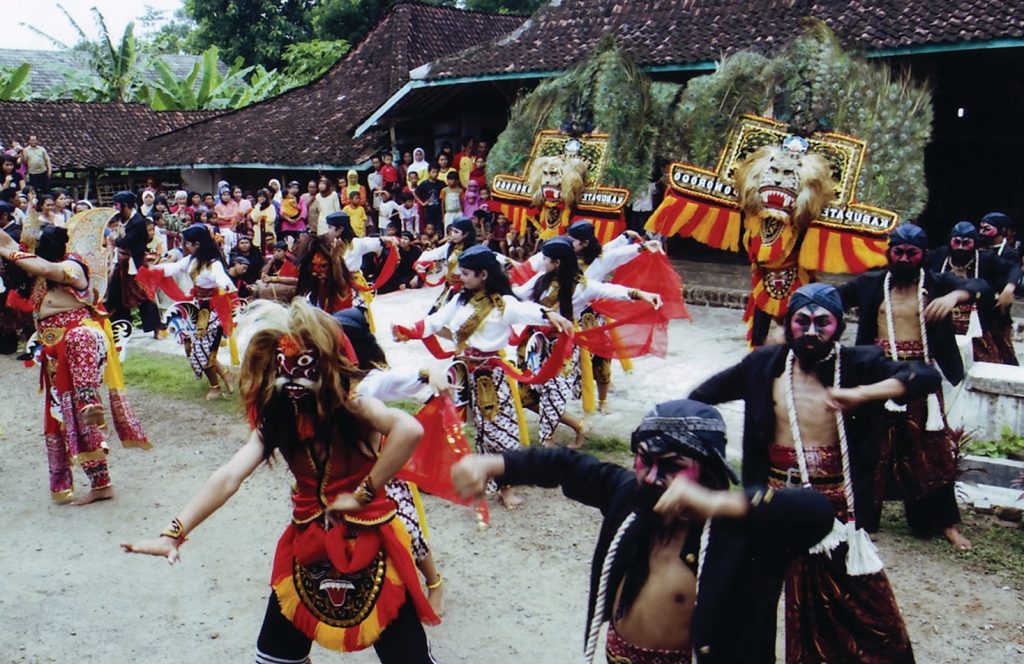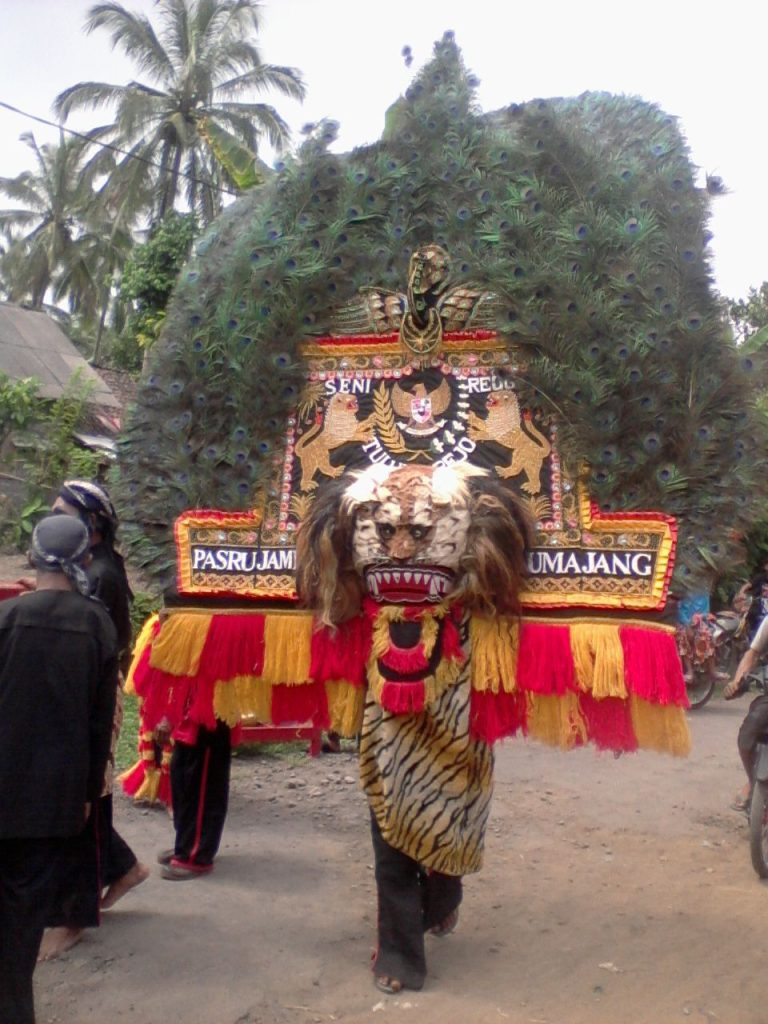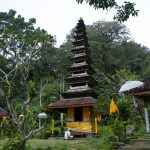Reog Ponorogo is listed as an important part of the intangible cultural heritage of Indonesia by UNESCO. – Never heard of it? Very few people outside of Indonesia have…and honestly many people IN Indonesia haven’t either! And it is listed as needing urgent protection. This is an amazing country, and there is so much diversity among the hundreds of cultures, ethnicities and islands. This is why we work so hard to share it with our guests!

Reog Ponorogo – what is it?
To even say there is a a single Indonesian heritage is an issue. It is a an almost overwhelming tapestry of cultures and complex. Reog Ponorogo has been granted this UNESCO status as it stands out as a captivating and mysterious art form. It is a traditional performance – often called a “dance” in English translations (but does not do it justice). It originates from East Java, in the Ponorogo regency.
Reog Ponorogo’s history is as colorful as its performances. Rooted in ancient Javanese mythology, the art form tells the story of King Klono Sewandono’s journey to win the hand of Princess Songgolangit. This legendary tale, passed down through generations, has evolved into a spectacular display of dance, music, and theatrics.
The performance features an array of characters, each with its own symbolic significance:
– Singo Barong: The iconic lion-tiger mask adorned with peacock feathers, representing power and beauty.
– Klono Sewandono: The proud king of Ponorogo.
– Bujang Ganong: Acrobatic dancers symbolizing youthful energy.
– Jathil: Horse riders embodying grace and agility.
– Warok: Spiritual leaders representing wisdom and strength.
The Mystique of the Mask
At the heart of Reog Ponorogo lies the awe-inspiring Singo Barong mask. Recognized as one of the largest masks in the world, it is a true marvel of craftsmanship and physical prowess. The dancer who wears this mask must possess extraordinary strength and skill, as they balance the massive 50-kilogram headdress using only their teeth.
This feat is so remarkable that it often transcends mere performance, entering the realm of the supernatural. Many believe that the dancers channel mystical powers, often entering trance-like states during their performances. As one observer noted, “The impossible unfolds before you in a tidal wave of color, movement, and noise. The rhythm tugs you in and you are there, submerged in the heady intoxication of Java.”
Reog Ponorogo – A Living Tradition
While Reog Ponorogo has ancient roots, it remains a vibrant and evolving tradition. Today, it serves multiple purposes:
Cultural Preservation: The art form keeps ancient stories and traditions alive for new generations. But see the warning within the UNESCO listing “However, the safeguarding process has not progressed as expected, as it is increasingly difficult to find Reog masters”
Community Bonding: Performances often mark important community events and celebrations.
Spiritual Practice: For many participants, Reog is a deeply spiritual experience, connecting them to ancestral beliefs.
Tourist Attraction: The spectacle draws visitors from around the world, showcasing Indonesia’s cultural richness. While there is always discussion around the viability and value of offering traditional performances for the gaze of the tourist, it is increasingly one of few ways to experience Reog Ponorogo

A Window into Indonesia
In many ways, Reog Ponorogo serves as a microcosm of Indonesia itself. It showcases the country’s ability to blend ancient traditions with modern sensibilities, to find harmony in diversity, and to create beauty from complexity. As visitors witness the swirling colors, pounding rhythms, and gravity-defying performances, they’re not just watching a show – they’re experiencing this thread to older cultures and meaning.
Reog Ponorogo is an example of the vast diversity of events across the archipelago and reminds us that in an increasingly globalized world, there are still pockets of wonder and mystery waiting to be discovered. It invites us to look beyond the surface, to delve into the stories and beliefs that shape a culture, and to appreciate the incredible diversity that makes our world so fascinating.
How long did it take for Reog Ponorog to achieve UNESCO status?
The recent inclusion of Reog Ponorogo on UNESCO’s List of Intangible Cultural Heritage marks the culmination of a lengthy and persistent effort by Indonesia to gain international recognition for this extraordinary art form. This achievement represents years of dedication and multiple attempts to secure UNESCO’s acknowledgment.
A Decade-Long Pursuit
The journey to UNESCO recognition for Reog Ponorogo has been a marathon rather than a sprint. As early as 2010, Indonesia had already submitted Reog Ponorogo for consideration as a UNESCO Intangible Cultural Heritage. Again in 2016. And again in 2022. All this time, the art form was still awaiting UNESCO’s decision, highlighting the complex and time-consuming nature of the recognition process
Persistent Efforts
Throughout the years, various stakeholders have been involved in this endeavor. The Local Government through its Department of Culture, Tourism, Youth and Sports (Disbudparpora), has been at the forefront of these efforts. They have consistently worked towards securing world recognition for Reog art. The process involved coordination between local authorities and national bodies. The Ponorogo Regency Government held audiences with the Directorate of Cultural Protection of the Ministry of Education, Culture, Research and Technology and the Indonesian National Commission for UNESCO (KNIU) multiple times. Finally, National government prioritization, when The Presidential Staff Office (KSP) emphasized that ensuring Reog Ponorogo’s recognition as an intangible cultural heritage was a government priority. They coordinated with the Coordinating Ministry for Human Development and Culture to meet UNESCO’s administrative requirements. The final submission that led to recognition was made in January 2024, demonstrating the ongoing nature of this process.
The full deal
Inscribed in 2024 (19.COM) on the List of Intangible Cultural Heritage in Need of Urgent Safeguarding
In Indonesia, Reog Ponorogo Performing Art is a centuries-old theatrical dance that is traditionally performed on various occasions, including disaster aversion ceremonies, village cleansing events, weddings, Islamic and national holidays, circumcisions, thanksgiving ceremonies, public festivities, and when welcoming guests. Dancers dress as kings, war commanders, knights and horse-mounted warriors to narrate the story of the Bantarangin Kingdom and its king. Reog is characterized by the Dadak Merak, a large mask resembling a tiger’s head with a peacock perched on top. For the Ponorogo community, it is a source of pride and an embodiment of cultural values. However, performances are dwindling due to an increasing preference for modern music shows, which are considered more practical and less expensive. Communities and the government have made various efforts to safeguard the practice, including by transmitting it through formal, informal and non-formal education. However, the safeguarding process has not progressed as expected, as it is increasingly difficult to find Reog masters. Furthermore, younger generations view the dance as unappealing and prefer to learn contemporary arts. As a result, there are insufficient students for the transmission of the related knowledge and skills, thereby endangering the sustainability of Reog Ponorogo Performing Art and the related crafts. https://ich.unesco.org/en/USL/reog-ponorogo-performing-art-01969
Join us in making travel a force for good. Together, we can create amazing experiences while preserving the beauty and culture of the destinations we love for generations to come.




